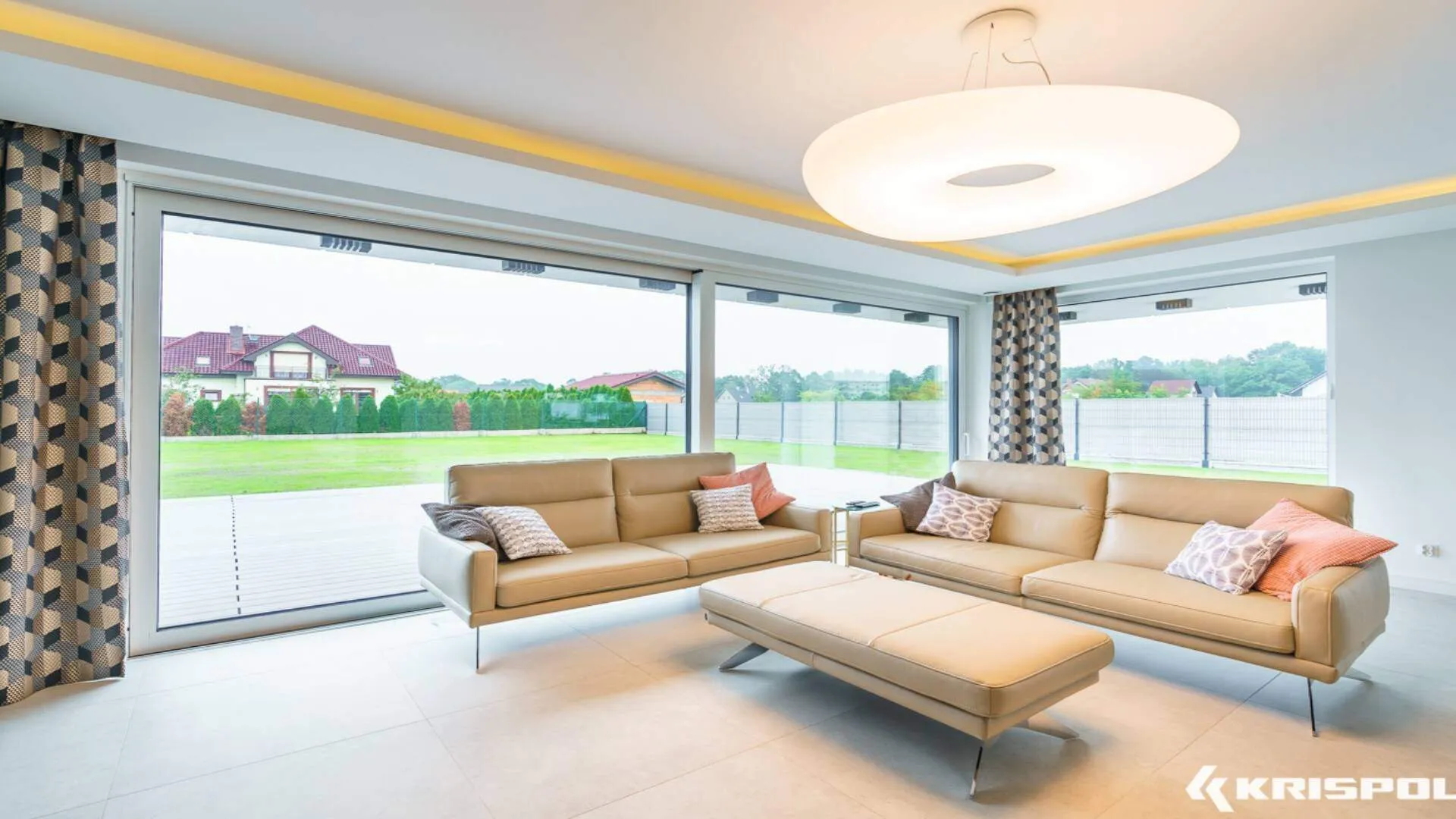
Advantages and disadvantages of the large windows
The leading architectural trend today revolves around large glazing, which significantly enhances interior spaces by providing abundant natural light. This improves overall living comfort and positively impacts the well-being of residents. Windows and glass doors that fulfill these criteria are increasingly popular among homeowners. However, while large windows offer numerous benefits, it’s essential to evaluate their potential drawbacks as well.
Regulations on Window Sizes
When selecting window sizes, you might wonder if the decision lies solely with the investor or is regulated by law. According to building regulations established by the Minister of Infrastructure, every room designed for occupancy (over four hours daily) must have permanent daylight access. This applies primarily to living rooms, bedrooms, or offices.
The law further specifies minimum window areas:
- Residential rooms: The window area must be at least 1/8 of the room’s floor area.
- Other daylight-requiring rooms: The ratio must be at least 1/12 of the room’s floor area.
Importantly, regulations do not impose an upper limit on window size, allowing flexibility in choosing large glazing options.
The Importance of Natural Light
Rooms without sufficient natural light pose health risks, including poor concentration, headaches, mood swings, and even insomnia. Hence, selecting adequate window sizes during the design phase is crucial. Properly sized windows ensure healthy daylight levels, contributing significantly to comfort and health.
Advantages of Large Windows
Large windows bring numerous benefits:
- Enhanced Well-being: Increased natural light positively affects mood, sleep quality, and productivity.
- Spaciousness and Aesthetics: Rooms appear larger, brighter, and more inviting, significantly enhancing interior design.
- Functional Integration: Sliding terrace doors seamlessly connect indoor and outdoor spaces, creating extended living areas.
- Passive Solar Heating: Large south-facing windows can naturally warm interiors during colder months, reducing heating costs.
- Connection with Nature: Expansive glazing frames outdoor views, integrating natural elements into your home’s ambiance.
Potential Disadvantages of Large Windows
Despite numerous advantages, large glazing presents certain challenges:
- Overheating Risk: Excessive solar energy during summer months can lead to uncomfortable indoor temperatures. Using external shading solutions like roller shutters can mitigate this issue.
- Heat Loss in Winter: Larger windows typically have higher heat loss potential. Choosing energy-efficient glazing with low U-values can counteract this.
- Privacy and Security Concerns: Increased glass surfaces may invite unwanted attention or compromise security. Solutions include using privacy screens, blinds, and opting for security-enhanced windows equipped with anti-burglary hardware, mushroom cams, and reinforced laminated glass.
Optimal Window Sizing
Architects typically match window sizes to room dimensions, ensuring compliance with legal requirements and optimal natural light. The current design preference favors expansive glazing systems, combining sliding doors and fixed windows (fixes), providing stylish and highly functional living spaces.
Installation of Large Windows
Installing large windows differs slightly from standard sizes. Typically, frames and glass panels arrive separately. First, the structural openings are prepared, frames installed and sealed to the walls, and finally, glazing panels carefully inserted. Due to their substantial weight and dimensions, specialized installation teams equipped with appropriate tools and machinery should carry out the installation process.
Conclusion
Choosing large windows requires careful consideration of benefits and challenges during the planning phase. Selecting an experienced provider that offers high-quality products and professional installation services ensures maximum enjoyment and long-term satisfaction. For additional guidance and comprehensive window solutions, explore AIMWIN’s extensive product range.
❓ FAQ – Advantages and Disadvantages of Large Windows
1. What are the main benefits of installing large windows?
Large windows flood spaces with natural light, making rooms feel brighter, more spacious, and healthier. They can also improve connection with nature, boost passive solar heating in colder months, and enhance home aesthetics (www.tampawindowtint.org).
2. Do large windows really save energy?
Yes—during the day, they reduce the need for artificial lighting. South-facing large windows can also harness solar heat in winter, lowering heating bills. However, without proper glazing or shading, they may cause heat gain in summer or heat loss in winter .
3. What are the drawbacks of large windows?
- Overheating in summer: large glass areas can let in too much sun, raising indoor temps.
- Higher heat loss: especially if insulation or frame quality isn’t optimal.
- Privacy concerns: clear view inside unless blinds or films are used.
- Security risks: more glass can be a vulnerability.
- More cleaning and maintenance: bigger surfaces require effort (www.tampawindowtint.org, fintecnic.pl).
4. Are large windows more expensive to install?
Yes—costs include larger glazing panels, stronger frames, and sometimes structural reinforcement. Floor‑to‑ceiling windows can start around $1,000 per panel, and need precise installation .
5. How can I mitigate privacy and security issues?
Use privacy-enhancing treatments like blinds, curtains, films, high-security laminated glass, or hardware such as mushroom cams and reinforced frames (www.tampawindowtint.org).
6. Is cleaning large windows difficult?
Absolutely. Their size—and sometimes height—can make cleaning cumbersome. Some homeowners hire professionals or use extendable tools and squeegees .
7. How do large windows compare to smaller ones?
Large windows offer dramatic views, light, and openness—but come with cost, maintenance, privacy, and thermal management concerns. Smaller windows are cheaper, easier to maintain, and more private, but typically let in less light (rbamilwaukee.com).
8. Are floor‑to‑ceiling windows worth it?
They create stunning visual effects, maximize light, and connect indoor-outdoor spaces—but require high investment, structural support, and smart temperature control solutions (e.g., low‑E glazing, shading, thermal curtains) (thespruce.com).
🔍 Related Articles – Learn More
- 📏 Window sizes – what should I look for?
Discover how to choose the right window sizes for your home, considering standard dimensions, customization options, and expert tips for a perfect fit. - 🔍 Top 7 questions to ask when buying large windows
Learn about the essential questions to consider when purchasing large windows, including material choices, energy efficiency, and installation considerations. - 🔄 Triple or double glazed windows?
Understand the differences between triple and double glazing, and how each option impacts energy efficiency, noise reduction, and overall comfort. - ❌ 7 most common window installation mistakes
Identify common pitfalls during window installation and learn how to avoid them to ensure optimal performance and longevity of your windows. - 🌿 The Ultimate Guide to Choosing Energy-Efficient Windows for Your Home
Explore comprehensive insights into selecting energy-efficient windows, including factors like frame materials, glazing options, and placement strategies.
The pros and cons of having large windows | homify


